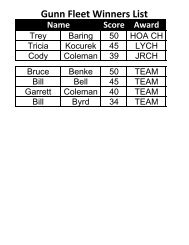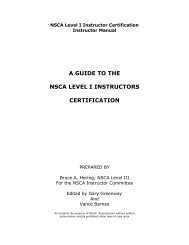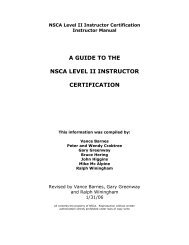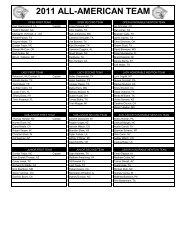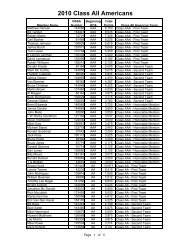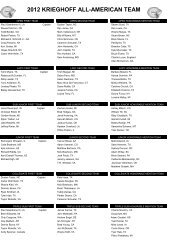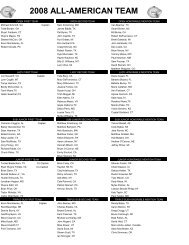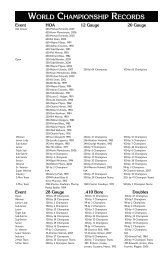New “Pull” Systems from Briley - NSSA-NSCA
New “Pull” Systems from Briley - NSSA-NSCA
New “Pull” Systems from Briley - NSSA-NSCA
You also want an ePaper? Increase the reach of your titles
YUMPU automatically turns print PDFs into web optimized ePapers that Google loves.
<strong>New</strong> <strong>“Pull”</strong> <strong>Systems</strong> <strong>from</strong> <strong>Briley</strong><br />
By Nick Sisley<br />
Electronics seem the way of the world these days, and modern-day electronics are stepping up to insure that we<br />
skeet shooters get a perfect “pull” 100 percent of the time. <strong>Briley</strong> Manufacturing in Housto n, Texas has stepped up to<br />
this electronic plate to offer more than one system for throwing these perfect electronic pulls.<br />
Enter the High Tech Voice Release Pickle—which I will also refer to as the wand. Over a year ago a <strong>Briley</strong> electronic<br />
prototype device similar to this was used at a <strong>Briley</strong>-sponsored skeet tournament. While that early wand worked,<br />
Cliff Moller at <strong>Briley</strong> knew it needed to be fine tuned. Typically, an electronic release will throw a skeet target, or a trap<br />
or sporting clays target, at the first noise the device hears.<br />
This problem is particularly germane to skeet squads and at sporting clays stations where squad members are<br />
prone to talking a bit, encouraging team mates, whatever. If a shooter comes off a station and a partner congratulat es<br />
with something like, “Great breaks,” a target can get thrown.<br />
This “chatter” is less of a problem in American trap as most squads get in a tempo —each of them calling pull<br />
within a few seconds of the last thrown target. So, there is no talking. When five shots are completed at a trap station<br />
the shooter on pad 5 walks to pad 1. Any talking during this time will cause a target(s) to be thrown. With International<br />
trap (bunker) and International skeet, participants are forbidden to talk at all. Consequently , unwanted targets that get<br />
thrown are minimal—if any at all in these latter two games.<br />
With <strong>Briley</strong>’s relatively new wand, throwing unwanted or uncalled for targets can be eliminated. Note the photos<br />
of the wand and where it can be properly positioned by the referee. The wand (about two feet long) is attached to what<br />
looks like a standard skeet pickle or push button. After the skeet shooter closes his gun the ref can push the proper<br />
button on the pickle—high, low or doubles. There’s no talking by the squad because squadmates know that their partner<br />
is getting ready to shoot. So the first sound the wand hears is “Pull.” Out comes a perfectly timed target.<br />
Initially, some experienced referees may not like the idea of the wand. They might be very experienced pullers<br />
and well noted for their great pulls—or some may think of themselves as great pullers. Some are, some are not.<br />
A second issue when using the wand is where the ref stands. Obviously, that position is going to have to be di fferent<br />
than the usual ref pulling spot. So there may be some refs who are uncomfortable with this new positioning—which<br />
is definitely closer to the shooter. Moller suggests that there has been some referee tendency to stand back<br />
too far and thus necessitate leaning forward appreciably. Again, note the photo of the properly positioned wand as the<br />
shooter is getting ready to call. Some referees can fail to get the wand up under the arm, or above the shoulder, where<br />
it should be. For obvious reasons some refs could be reluctant in this positioning with women.<br />
On the positive side, many referees love the wand system because they don’t have to worry about giving even a<br />
good pull, let alone a perfect one, 500 times in a row on a five -man squad. In contrast refs can focus their full attention<br />
more on rulings.<br />
In some areas of the country experienced referees are difficult to find, especially for finding a lot of experienced<br />
refs say for a big shoot. But with the wand there’s not as much need for referee experience. At the California State<br />
Shoot last year, after the 500 targets were pulled in one event, one of the shooters asked the referee, “How do you like<br />
the wand and the electronic system of throwing targets?”<br />
That ref came back with, “I don’t know what you mean sir.” Through further questioning by the shooter, it was<br />
discovered that this referee had never used the old system (I say old system, but, of course, this is the system used<br />
even today at most clubs) a normal skeet pickle and pushing the button after each “pull” call. This reac tion by the obviously<br />
new ref in California does further indicate that vast pulling experience is not necessary when using the wand.<br />
<strong>Briley</strong> is in the process of making an instructional video for referees on the use of this wand device. Moller suggests,<br />
“Referees should look specifically at the wand when putting it into the correct position. They should not look up<br />
away <strong>from</strong> the wand, like toward the house, until the bird has been released. If the referee looks for the target before<br />
the target release, there is a tendency for the end of the wand to wave around, in some cases touching the shooter at<br />
this critical time.”<br />
<strong>Briley</strong> was having some issues with high winds triggering unwanted targets. Cliff worked with Billy Williams, who
shoots a lot in Montana, and Paul <strong>New</strong>man, who shoots a lot in <strong>New</strong> Mexico (both areas noted for wind) to come up<br />
with a wind guard on the wand that now works well (i.e. not throwing unwanted targets) even in winds of 40 miles per<br />
hour, and, of course, most of us don’t want to shoot in such windy conditions anyway.<br />
Target counting systems are becoming popular because they are such money savers to gun clubs. The wand can<br />
be purchased with a counter. When shooting practice just turn the wand back in at the club and the number of targets<br />
thrown is clearly shown—so pay for the number of birds you have shot. Clubs can also purchase a module that can be<br />
wired into the clubhouse—also for counting targets.<br />
The current wand cost is $300— and this includes the 100-foot cord to go with it. This unit uses a 12 volt system.<br />
If your fields are wired for 110 volts that takes a $100 converter, also available <strong>from</strong> <strong>Briley</strong>. The counter for the wand<br />
also is an additional $100, which should pay for itself very quickly according to every club target record I’m aware of.<br />
As Moller says, “This is a very inexpensive way to control target costs.”<br />
Further, the wand has a manual mode as the electronic mode where you can just press the pickle button(s) as<br />
you normally would. <strong>Briley</strong> has also come up with an inexpensive wand that shooters can use privately—i.e. when<br />
shooting alone. This is a very short wand—only a few inches long—also<br />
attached to an electronic pickle. Just put the short wand in your shooting pouch. Press the button on the pickle for the<br />
target(s) that you want thrown, don’t say anything, call for the bird and out comes the target in perfect timing. You can<br />
also have a two second delay built into this short wand. Compared to some electronic -throwing systems the short wand<br />
looks like a real cost winner.<br />
The regular wand is also perfect for sporting clays stations. Use a 3 to 6 foot electric cord that you hook up to the<br />
power on each station and throw the sporting birds you want, including doubles. This is another target saver if the $100<br />
counter is added. Bring the wand back to the clubhouse; if the counter says you threw 320 targets, that’s what you pay<br />
for. No trap boys are required.<br />
It should be pointed out that in skeet or sporting—you don’t pay for broken birds with this system. That’s because<br />
counting only takes place electronically through the sound of the shot. So if a bird comes out broken and you don’t<br />
shoot —the built-in counter doesn’t count that broken target.<br />
There’s a lot more available electronically <strong>from</strong> <strong>Briley</strong>, including the iPull (capable of performing far more functions<br />
than the wand), coin boxes for buying x-number of targets, an eight-trap machine control box, other electronic<br />
pickles, the Elfipa Skeet Release and more —all of which could be material for future verbiage in this column. Check<br />
out www.briley.com.<br />
Nick Sisley has been writing about the outdoors for over 41 years. He has written between 4000 and 5000 magazine<br />
articles, authored eight books, is a Level I <strong>NSSA</strong> and <strong>NSCA</strong> shotgun instructor, an NRA certified shotgun instru ctor<br />
and has traveled worldwide in search of story material, usually with a shotgun. He can be reached at nicksi sley@hotmail.com.



